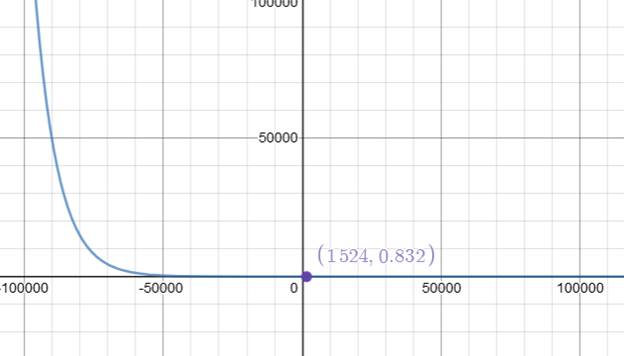
Concept explainers
a.
To Identify: The Initial amount, decay factor and decay rate.
a.
Answer to Problem 17CT
Initial amount =1
Decay factor=0.99988
Decay rate=0.012%
Explanation of Solution
Given information: The equation
Formula used:
Calculation:
Let’s compare the given equation with formula.
Initial amount A=1
Decay factor
To find decay rate, let’s solve
Subtract both sides 1.
Divide both sides by -1.
Multiply it by 100% to get decay rate in percent.
b.
To find: Pressure at an altitude of 5000 feet.
b.
Answer to Problem 17CT
Pressure is 0.833 atmosphere.
Explanation of Solution
Given information: Graph the function using graphing calculator and find the P when a =1524 feet.
Calculation:
Let’s graph using online graphing calculator.
Before graph it, it needed to change 5000 feet to meters. Because our ‘a’ represents in meters.
1 meter = 3.28084 foot
So, 5000 feet could be found by dividing 5000 by 3.28084.
So, 5000 feet = 1524 meters

Interpretation: The pressure is 0.833 atmospheres approximately when altitude is 5000 feet(1524 meters).
Chapter 6 Solutions
BIG IDEAS MATH Algebra 1: Common Core Student Edition 2015
- 5) 8.4 6.3 ?arrow_forwardWendy is looking over some data regarding the strength, measured in Pascals (Pa), of some rope and how the strength relates to the number of woven strands in the rope. The data are represented by the exponential function f(x) = 2x, where x is the number of woven strands. Explain how she can convert this equation to a logarithmic function when strength is 256 Pascals. Please type out answerarrow_forwardHarrison and Sherrie are making decisions about their bank accounts. Harrison wants to deposit $200 as a principal amount, with an interest of 2% compounded quarterly. Sherrie wants to deposit $200 as the principal amount, with an interest of 4% compounded monthly. Explain which method results in more money after 2 years. Show all work. Please type out answerarrow_forward
- Mike is working on solving the exponential equation 37x = 12; however, he is not quite sure where to start. Solve the equation and use complete sentences to describe the steps to solve. Hint: Use the change of base formula: log y = log y log barrow_forwardUsing logarithmic properties, what is the solution to log3(y + 5) + log36 = log366? Show all necessary steps.arrow_forward4.2 Comparing Linear and Exponential Change 7) Money is added to (and never removed from) two different savings accounts (Account A and Account B) at the start of each month according to different mathematical rules. Each savings account had $500 in it last month and has $540 in it this month. (a) Assume the money in Account A is growing linearly: How much money will be in the account next month? How much money was in the account two months ago? How long will it take for the account to have at least $2500? Write an equation relating the amount of money in the account and the number of months from now. Clearly define the meaning of each variable in your equation, and interpret the meaning of each constant in your equation. (b) Assume the money in Account B is growing exponentially. How much money will be in the account next month? How much money was in the account two months ago? How long will it take for the account to have at least $2500? Write an equation relating the amount of money…arrow_forward
- Which of the following is the solution to the equation 25(z − 2) = 125? - Oz = 5.5 Oz = 3.5 Oz = -2.5 z = -0.5arrow_forwardAnalyze the graph below to identify the key features of the logarithmic function. 2 0 2 6 8 10 12 2 The x-intercept is y = 7, and the graph approaches a vertical asymptote at y = 6. The x-intercept is x = 7, and the graph approaches a vertical asymptote at x = 6. The x-intercept is y = -7, and the graph approaches a vertical asymptote at y = −6. The x-intercept is x = -7, and the graph approaches a vertical asymptote at x = −6.arrow_forwardCompare the graphs below of the logarithmic functions. Write the equation to represent g(x). 2 f(x) = log(x) 2 g(x) -6 -4 -2 ° 2 0 4 6 8 -2 - 4 g(x) = log(x) - g(x) = log(x) + 4 g(x) = log(x+4) g(x) = log(x-4) -2 -4 -6arrow_forward
- Which of the following represents the graph of f(x)=3x-2? 3 2 • 6 3 2 0- 0- • 3 2 0 -2 3arrow_forward2) Suppose you start with $60 and increase this amount by 15%. Since 15% of $60 is $9, that means you increase your $60 by $9, so you now have $69. Notice that we did this calculation in two steps: first we multiplied $60 by 0.15 to find 15% of $60, then we added this amount to our original $60. Explain why it makes sense that increasing $60 by 15% can also be accomplished in one step by multiplying $60 times 1.15. 3) Suppose you have $60 and want to decrease this amount by 15%. Since 15% of $60 is $9, that means you will decrease your $60 by $9, so you now have $51. Notice that we did this calculation in two steps: first we multiplied $60 by 0.15 to find 15% of $60, then we subtracted this amount from our original $60. Explain why it makes sense that decreasing $60 by 15% can also be accomplished in one step by multiplying $60 times 0.85. 4) In the Read and Study section, we noted that the population in Colony B is increasing each year by 25%. Which other colony in the Class Activity…arrow_forward5) You are purchasing a game for $30. You have a 5% off coupon and sales tax is 5%. What will your final price be? Does it matter if you take off the coupon first or add in the tax first? 6) You have ten coupons that allow you to take 10% off the sales price of a jacket, and for some strange reason, the store is going to allow you to use all ten coupons! Does this mean you get the jacket for free? Let's really think about what would happen at the checkout. First, the teller would scan the price tag on the jacket, and the computer would show the price is $100. After the teller scans the first coupon, the computer will take 10% off of $100, and show the price is $90. (Right? Think about why this is.) Then after the teller scans the second coupon, the computer will take 10% off of $90. (a) Continue this reasoning to fill in the table below showing the price of the jacket (y) after you apply x coupons. (b) Make a graph showing the price of the jacket from x = 0 to x = 10 coupons applied.…arrow_forward
 Algebra and Trigonometry (6th Edition)AlgebraISBN:9780134463216Author:Robert F. BlitzerPublisher:PEARSON
Algebra and Trigonometry (6th Edition)AlgebraISBN:9780134463216Author:Robert F. BlitzerPublisher:PEARSON Contemporary Abstract AlgebraAlgebraISBN:9781305657960Author:Joseph GallianPublisher:Cengage Learning
Contemporary Abstract AlgebraAlgebraISBN:9781305657960Author:Joseph GallianPublisher:Cengage Learning Linear Algebra: A Modern IntroductionAlgebraISBN:9781285463247Author:David PoolePublisher:Cengage Learning
Linear Algebra: A Modern IntroductionAlgebraISBN:9781285463247Author:David PoolePublisher:Cengage Learning Algebra And Trigonometry (11th Edition)AlgebraISBN:9780135163078Author:Michael SullivanPublisher:PEARSON
Algebra And Trigonometry (11th Edition)AlgebraISBN:9780135163078Author:Michael SullivanPublisher:PEARSON Introduction to Linear Algebra, Fifth EditionAlgebraISBN:9780980232776Author:Gilbert StrangPublisher:Wellesley-Cambridge Press
Introduction to Linear Algebra, Fifth EditionAlgebraISBN:9780980232776Author:Gilbert StrangPublisher:Wellesley-Cambridge Press College Algebra (Collegiate Math)AlgebraISBN:9780077836344Author:Julie Miller, Donna GerkenPublisher:McGraw-Hill Education
College Algebra (Collegiate Math)AlgebraISBN:9780077836344Author:Julie Miller, Donna GerkenPublisher:McGraw-Hill Education





